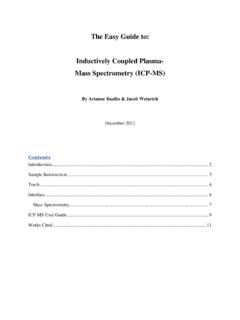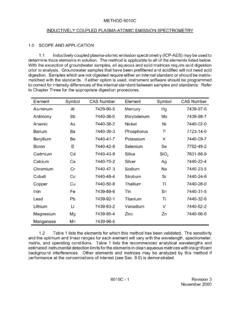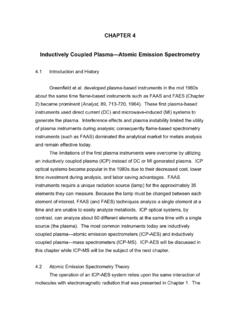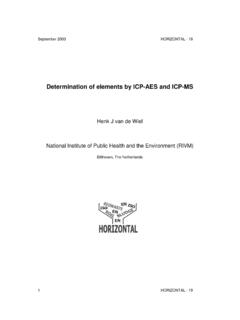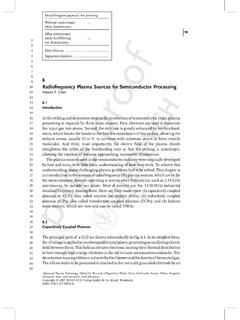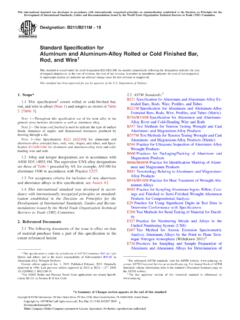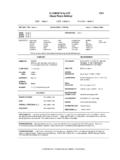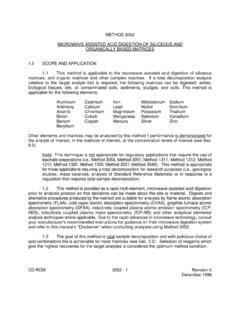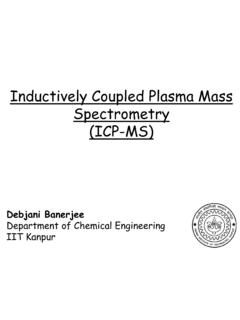Transcription of METHOD 6020B INDUCTIVELY COUPLED PLASMA—MASS …
1 SW 846 Update V 6020B 1 Revision 2 July 2014 METHOD 6020B INDUCTIVELY COUPLED plasma mass SPECTROMETRY SW 846 is not intended to be an analytical training manual. Therefore, METHOD procedures are written based on the assumption that they will be performed by analysts who are formally trained in at least the basic principles of chemical analysis and in the use of the subject technology. In addition, SW 846 methods , with the exception of required METHOD use for the analysis of METHOD defined parameters, are intended to be guidance methods which contain general information on how to perform an analytical procedure or technique which a laboratory can use as a basic starting point for generating its own detailed standard operating procedure (SOP), either for its own general use or for a specific project application.
2 The performance data included in this METHOD are for guidance purposes only, and are not intended to be and must not be used as absolute quality control (QC) acceptance criteria for purposes of laboratory accreditation. SCOPE AND APPLICATION INDUCTIVELY COUPLED plasma mass spectrometry (ICP MS) is applicable to the determination of sub ;g/L concentrations of a large number of elements in water samples and in waste extracts or digests (Refs. 1 and 2). When dissolved constituents are required, samples must be filtered and acid preserved prior to analysis.
3 No digestion is required prior to analysis for dissolved elements in water samples. Acid digestion prior to filtration and analysis is required for groundwater, aqueous samples, industrial wastes, soils, sludges, sediments, and other solid wastes for which total (acid leachable) elements are required. The analyst should insure that a sample digestion METHOD is chosen that is appropriate for each analyte and the intended use of the data. Refer to Chapter Three for the appropriate digestion procedures. ICP MS has been applied to the determination of over 60 elements in various matrices.
4 Analytes for which the acceptability of METHOD 6020 has been demonstrated through multi laboratory testing on solid and aqueous wastes are listed below. Element Symbol CASRNa Element Symbol CASRNa Aluminum Al 7429 90 5 Magnesium Mg 7439 95 4 Antimony Sb 7440 36 0 Manganese Mn 7439 96 5 Arsenic As 7440 38 2 Mercury Hg 7439 97 6 Barium Ba 7440 39 3 Nickel Ni 7440 02 0 Beryllium Be 7440 41 7 Potassium K 7440 09 7 SW 846 Update V 6020B 2 Revision 2 July 2014 Element Symbol CASRNa Element Symbol CASRNa Cadmium Cd 7440 43 9 Selenium Se 7782 49 2 Calcium Ca 7440 70 2 Silver Ag 7440 22 4 Chromium Cr
5 7440 47 3 Sodium Na 7440 23 5 Cobalt Co 7440 48 4 Thallium TI 7440 28 0 Copper Cu 7440 50 8 Vanadium V 7440 62 2 Iron Fe 7439 89 6 Zinc Zn 7440 66 6 Lead Pb 7439 92 1 aChemical Abstract Service Registry Number The performance acceptability of ICP MS for the determination of the listed elements was based upon comparison of the multi laboratory testing results with those obtained from either furnace atomic absorption spectrophotometry or INDUCTIVELY COUPLED plasma optical emission spectrometry. It should be noted that one multi laboratory study was conducted in 1988.
6 As advances in ICP MS instrumentation and software have been made since that time, other elements have been added through validation and with additional improvements in performance of the METHOD . Performance, in general, presently exceeds the original multi laboratory performance data for the listed elements (and others) that are provided in Sec. Instrument detection limits (IDLs), lower limits of quantitation (LLOQs) and linear ranges will vary with the matrices, instrumentation, and operating conditions. In relatively simple matrices, IDLs will generally be < ;g/L.
7 For less sensitive elements ( , Se and As) and desensitized major elements, IDLs may be ;g/L. If METHOD 6020 is used to determine any analyte not listed in Sec. , it is the responsibility of the analyst to demonstrate the precision and bias of the METHOD for the waste to be analyzed. The analyst must always monitor potential sources of interferences and take appropriate action to ensure data of known quality (see Sec. ). Other elements and matrices may be analyzed by this METHOD if performance is demonstrated for the analyte of interest, in the matrices of interest, at the concentration levels of interest in the same manner as the listed elements and matrices (see Sec.)
8 Use of this METHOD should be restricted to spectroscopists who are knowledgeable in the recognition and correction of spectral, chemical, and physical interferences in ICP MS analysis. An appropriate internal standard is necessary for each analyte determined by ICP MS. Recommended internal standards are 6Li, 45Sc, 89Y, 103Rh, 115In, 159Tb, 165Ho, and 209Bi. The lithium internal standard should have an enriched abundance of 6Li, so that SW 846 Update V 6020B 3 Revision 2 July 2014 interference from lithium native to the sample is minimized.
9 Other elements may need to be used as internal standards when samples contain significant native amounts of the recommended internal standards as indicated by high bias of internal standard recoveries. Note: Other potential causes of a high bias should also be considered before a final decision is made that the internal standard high bias is caused by an excessive concentration of the internal standard isotope in the sample. Prior to employing this METHOD , analysts are advised to consult the preparatory METHOD for each type of procedure that may be employed in the overall analysis ( , methods 3005, 3010, 3015, 3031, 3040, 3050, 3051, 3052, 7000, and 6800) for additional information on QC procedures, development of QC acceptance criteria, calculations, and general guidance.
10 Analysts also should consult the disclaimer statement at the front of the manual and the information in Chapter Two for guidance on the intended flexibility in the choice of methods , apparatus, materials, reagents, and supplies, and on the responsibilities of the analyst for demonstrating that the techniques employed are appropriate for the analytes of interest, in the matrix of interest, and at the levels of concern. In addition, analysts and data users are advised that, except where explicitly specified in a regulation, the use of SW 846 methods is not mandatory in response to Federal testing requirements.










